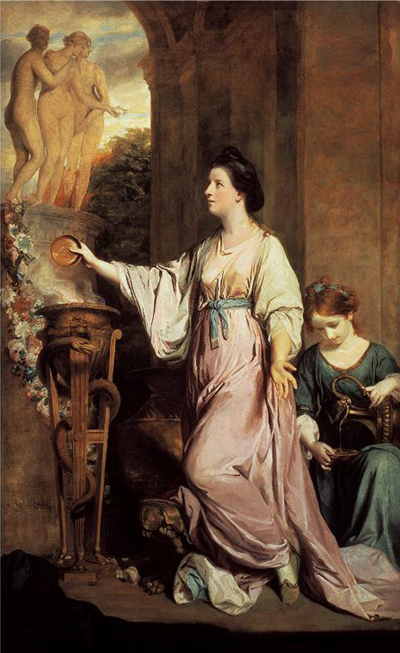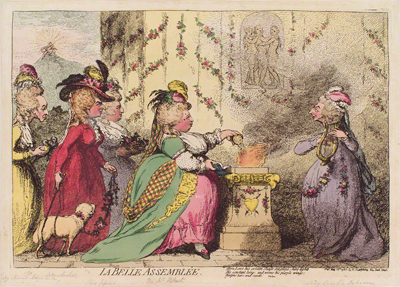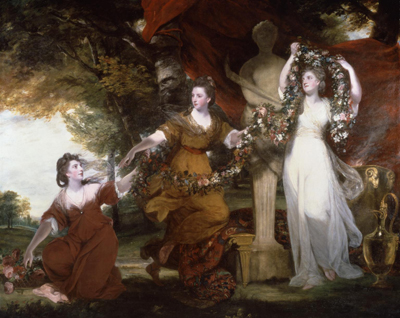La Belle Assemblée
Gillray was intensely aware of the "serious": art of his time and was never loathe to imitate and use it for his own satiric purposes. In his Saint Cecilia (1782), for instance, Gillray parodied Joshua Reynold's portrait of Mrs. Richard Brinsley Sheridan as St Cecilia in order to contrast his Cecila, the sour-looking Mrs. Cecilia Johnston (who also appears here) with the beautiful Mrs. Sheridan and the genuine Saint Cecilia. And in La Belle Assemblée, five years later, he was at it again.
Sir Joshua Reynolds, the President of the Royal Academy of the Arts, had made a career of promoting the "Grand Style" of portraiture in which sitters would be elevated and ennobled by appearing in vaguely classical dress, in poses that recalled Greek or Roman sculpture, or performing actions that would suggest ancient and revered rituals. In La Belle Assemblée, Gillray alludes to two such works by Reynolds—Lady Sarah Bunbury Sacrificing to the Graces (1765) and Three Ladies Adorning a Term of Hymen (1774).

Lady Sarah Bunbury Sacrificing to the Graces [1767]
© The Art Institute of Chicago
In the center of La Belle Assemblée Gillray borrows the principal action of Reynolds' Lady Sarah..., the pouring of incense on a fire beneath an image of the three graces. But while the Reynolds portrait features the young, elegant, and classically garbed Lady Sarah Bunbury, Gillray's parody gives us the 50 year old, overstuffed Mrs. Albinia Hobart in modern dress. And while Lady Sarah is making her sacrifice appropriately to the Graces, the already married Lady Albinia is paying an awkwardly belated tribute to the god of love. In her hand is a book entitled Ninon, likely a mistake for Nina a two act play translated from the French by George Monck Berkeley in 1787 and dedicated to Mrs Hobart. The subtitle of that play may have been part of Gillray's joke; it is "The Madness of Love."

© National Portrait Gallery
But Mrs. Hobart is not the only devotee of the love god. Like Reynold's painting of the three Montgomery sisters, there are additional ladies in contrasting colors performing these rites. And while the garlands in Gillray's version are background decoration and not held by the ladies, Gillray's flaming ram's head altar is similar enough to the one in Three Ladies... to suggest that he had both Reynold's paintings in mind.

Three Ladies Adorning a Term of Hymen [1774]
© Trustees of the Tate Gallery, London
Most of the other women in La Belle Assemblée are easily identified from other Gillray prints. The woman playing the lyre is, of course, the musical Cecilia Johnston, from Gillray's St. Cecilia. The woman on the far left holding two pigeons (love birds) for sacrifice is Lady Mount Edgcumbe, who will appear four years later in Gillray's A Witch upon a Mount's Edge. The lady in red is the widow Lady Sarah Archer who was famous for her riding skills (hence the riding outfit and whip), her liberal use of cosmetics (hence the striking rouge on her cheek), and her attempts to control her daughters (hence the lamb being led by a garland leash to the slaughter?). She appears attired in very similar ways in Gillray's The Finishing Touch [1791]. The last woman, carrying flowers, is Elizabeth Jeffries (according to M. Dorothy George), Maid of Honor to Queen Charlotte, who appears in a number of other prints at the time, often in company with one or more of the other women in Gillray's print.
In the background, Apollo with the sun at his back can just be seen playing a Lira da Braccio as he does in Raphael's Apollo on Mount Parnassus. This may be simply another instance where Gillray contrasts ancient and modern, serious and trivial. But since we have another musician playing a lyre at the opposite end of the picture, there may be a slight hint of the contest between Apollo and Marsyas, a contest that was usually read in the 18th century as an instance of hubris. If so, it is consistent with what I take to be the general theme of Gillray's print which really cuts two ways. It shows a group of unmistakably older women, still pretending to love and beauty. And it exposes the artificiality and pretentiousness of the Grand Style when it is applied to modern women, whose dress and size and features have not been enhanced by the portraitist.
Sources and Reading
- Commentary from the British Museum on La Belle Assemblée
- Draper Hill, Fashionable Contrasts, 1966, #80
- "Joshua Reynolds," Wikipedia
- Thomas Wright and R.H. Evans, Historical and Descriptive Account of the Caricatures of James Gillray #374
Comments & Corrections
NOTE: Comments and/or corrections are always appreciated. To make that easier, I have included a form below that you can use. I promise never to share any of the info provided without your express permission.